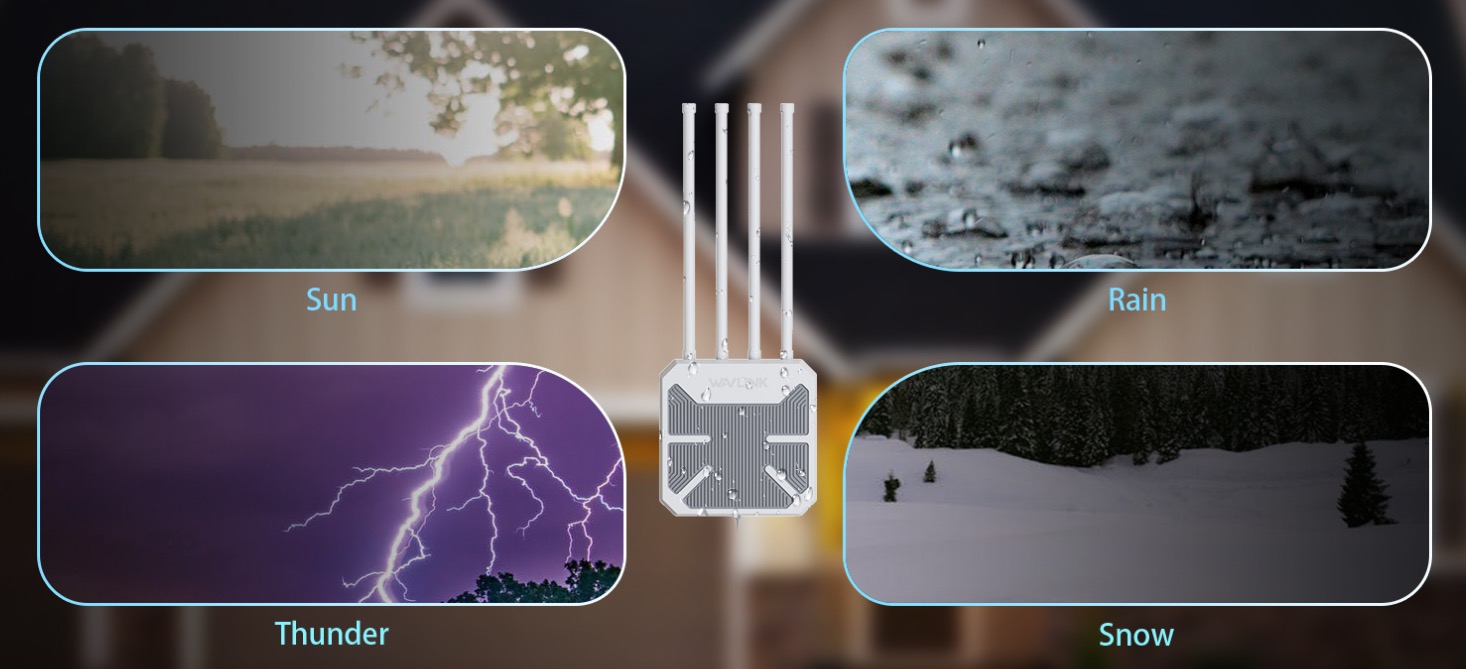Do you want to watch sports events in your garden or work on your laptop while relaxing on the patio, all while staying connected to your home WiFi network?

How to Extend Wi-Fi Outdoors?
Sometimes, relying solely on your indoor router might not suffice for these needs. The ability to extend your indoor wireless signal to the great outdoors depends on how far you want that WiFi signal to reach – whether it's just your balcony or porch or if you aim to cover your entire garden.
If you're looking to expand the WiFi signal just a few feet beyond your window or door, you can consider placing a wireless extender indoors, near the area you want to cover. However, if you want to provide reliable coverage to a larger outdoor space, the best solution is to acquire an outdoor router to serve as a WiFi access point. If you already have a whole-home WiFi system (mesh WiFi) in place, you can extend your wireless network outdoors by adding more mesh WiFi nodes.
Understanding the Basics of Extending WiFi Outdoors
Before delving into the specifics of extending your WiFi outdoors, let's explore the fundamentals of how this works.
WiFi Extenders
WiFi extenders, also known as wireless range extenders or repeaters, are devices designed to enhance and extend your existing WiFi coverage. These devices receive the WiFi signal from your router and retransmit it, effectively extending its range.
You plug them into power outlets, and they capture your existing WiFi signal, amplify it, and then transmit the boosted signal. In theory, using WiFi extenders can extend your indoor WiFi signal to your outdoor garden. However, this method first requires the WiFi extender to connect wirelessly to your main router, and many factors can affect the strength and speed of the WiFi connection. One major factor is the position of your router. If your main router is placed in the front of a large house, and you want to extend the wireless signal to the garden behind, how your WiFi extender wirelessly communicates with the main router becomes a critical issue.
If your main goal is to cover a small outdoor area like a porch or patio, using a WiFi extender can be a cost-effective solution.
Wireless Access Points (AP)
The most reliable way to extend your wireless network outdoors is to use Wireless Access Points (AP) connected to your indoor router via Ethernet cables. This method ensures stable and reliable network access from your indoor router, without worrying about signal attenuation due to brick walls or distance. If you have a Power over Ethernet (PoE) switch, outdoor APs won't even require separate power sources.
Mesh WiFi Systems
If you want comprehensive WiFi coverage for both your indoor and outdoor areas, you can consider a mesh WiFi system. Mesh WiFi systems, also known as whole home WiFi systems, consist of a central router and multiple satellite nodes. Each node serves as a link in the chain, intelligently finding the best signal transmission path. This means even nodes farthest from the router can still deliver a strong signal.
If you have a large house, extensive garden, or outdoor devices like automatic garage doors that need a wireless signal, mesh WiFi might be your best choice. It not only provides more reliable and robust WiFi connectivity but also enables seamless roaming between indoor and outdoor spaces.
Can Extenders, APs, and Mesh Routers Be Used Outdoors?
If these wireless devices are placed outdoors, they will face challenges like exposure to wind, sun, rain, dust, and even extreme temperatures. Therefore, if you intend to use router equipment outdoors, it's essential to purchase outdoor-rated devices.
The WAVLINK WiFi 6 AX1800 is a wireless access point specifically designed for outdoor use, with an IP67 weather protection rating. It can operate in extreme weather conditions, including rain, snow, thunderstorms, and temperatures ranging from -20°C to 50°C.

This product adheres to the Wi-Fi 6 (802.11ax) standard, offering dual-frequency bands (2.4GHz and 5GHz), PoE power supply support, and the ability to switch between AP, Range Extender, and Mesh WiFi modes. It's a versatile device that can accommodate various outdoor wireless expansion needs.
Tips for Setting Up Outdoor WiFi
Here are some practical steps to ensure you achieve excellent WiFi coverage in your garden:
Assess Your Outdoor Coverage Needs: Determine how far you need your WiFi signal to reach. This will guide your equipment choice and placement.
1, Assess Your Outdoor Coverage Needs: Determine how far you need your WiFi signal to reach. This will guide your choice of equipment and placement.
2, Select the Right Equipment: Choose between WiFi extenders for smaller outdoor areas or outdoor wireless access points for larger coverage. If you have a mesh WiFi system, consider adding a mesh node for outdoor extension.
3, Find the Ideal Location: For outdoor wireless access points, find the optimal mounting location on an exterior wall. Ensure it's sheltered from extreme weather conditions.
4, Secure Your Outdoor Equipment: Outdoor devices should be weatherproofed and secured against theft or tampering.
5, Configure Your Equipment: Follow the manufacturer's instructions to set up and configure your chosen equipment. Ensure proper security settings, such as strong passwords and encryption.
6, Test Signal Strength: Use a WiFi signal strength app or device to check the signal quality in different areas of your garden to make sure you have adequate coverage.
7, Consider Network Segmentation: If you have specific outdoor IoT devices like security cameras, consider segmenting your network for added security.
8, Regular Maintenance: Perform routine maintenance to ensure your outdoor WiFi equipment remains in good working condition.
By following these steps and selecting the right equipment, you can enjoy a robust and dependable WiFi signal in your garden, enabling various outdoor activities such as streaming sports events or working in the sunshine. A well-extended outdoor WiFi network can make it all possible.
Get the Scoop First
Subscribe to our official website to receive exclusive first-hand news and stay up-to-date on our new product releases and promotions!